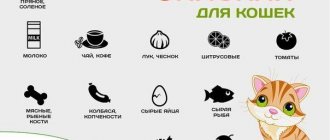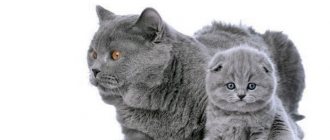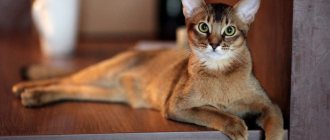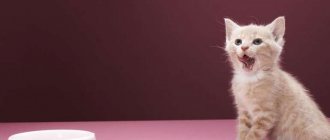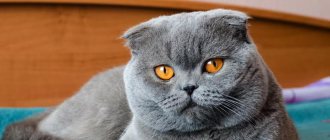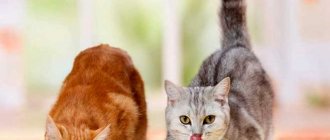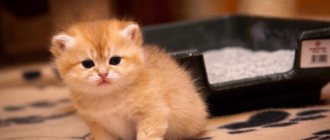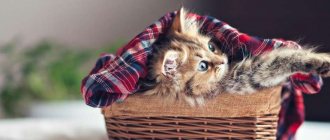Home » Useful Information
In order for your pet to grow healthy and beautiful, you need to choose the right diet for it. And Scottish Fold cats are no exception. Like all purebred animals, they need high-quality feed rich in vitamins, minerals and other beneficial substances. If you decide to get yourself a cat of this breed, be sure to read the recommendations for feeding it.
- 1.1 What to consider when choosing a type of food
1.1.1 Video: basic principles of feeding cats
- 2 Features of food selection
2.1 For kittens
2.1.1 Table: food for Scottish Fold kittens
- 2.1.2 Photo gallery: food for Scottish Fold kittens
- 2.1.3 Video: first feeding of kittens
- 2.1.4 Natural products in a kitten’s diet
- 2.2.1 Table: food for adult Scottish Fold cats
Features of the Scottish Fold breed
Charming Scottish Fold cats with an unusual appearance have another name - Scottish Fold. A peculiarity of the breed and a distinctive feature of these animals are small ears, the tips of which are curved down and forward. This trait is the result of a gene mutation.
Folds are animals that have a strong build and are medium or large in size. Their fur is soft, short, elastic, slightly plush to the touch and very thick. The colors can be any: plain (chocolate, cream, blue, black, etc.), with a pattern (brindle, marble, spotted), combination with white. Color point color is also allowed.
The homeland of such cats is Great Britain. A fold-eared cat was born on a Scottish farm and was given the name Susie. Later she gave birth to several more kittens with such ears, after which breeders began developing the breed.
INTERESTING! Experts have found that the lop ear gene is semi-fatal. It weakens cartilage and therefore can lead to the development of pathologies of the musculoskeletal system. Because of this discovery, the breed was banned in the UK, and American breeders continued to work on it.
They conducted a lot of research and came to the following conclusion. When Scottish Folds were mated with straight-eared cats (British or American Shorthair), the result was offspring devoid of the double defective gene.
Some kittens had ears characteristic of the breed, while others had standard ears. Since 2004, animals with straight ears have been called Scottish Straights. It is with such representatives that Scottish Fold cats are allowed to be bred.
Choosing dishes and arranging a feeding area
A bowl for a Scottish Fold kitten should be spacious and stable. There must be at least two of them: one for food, the other for drinking water. However, if your pet eats both dry food and canned food or natural food, it is better to have its own plate for each type of food.
Cat bowls can be different:
- Ceramic or earthenware. These bowls are very heavy, so they stay in one place and don’t roll all over the floor. They wash well and do not add any foreign odors to water or food. Such bowls are most preferable for Scottish Fold babies.
- Metal. Such plates can be installed on a special stand. Some bowls have a rubber band around the edge to hold the bowl in place.
- Plastic. These bowls are lightweight, quite stable, and come in a variety of shapes. They can be single, double, with an additional wide stand in the form of a tray, etc.
The kitten's bowl should be quite wide, but not deep. A plate with a volume of 0.1 to 0.4 liters is suitable for food. It is better to choose larger containers for drinking water: from 1 to 2-3 liters.
An alternative to a regular bowl can be an automatic feeder. This device independently dispenses food to your pet up to 6 times a day, depending on the set mode. Instead of a water dish, you can provide your lop-eared kitten with a special fountain in which the liquid constantly circulates and remains fresh.
When choosing a place and dishes, you need to take into account the behavioral characteristics of cats. It is better to install plates for your pet in a stationary place so that your pet gets used to them. Bowls of food and water should be placed next to each other. The best place for cat dishes is a dark corner in the kitchen or dining room.
You can place a special mat or a wide tray under them. Once every 1-2 days, wash the bowls well with hot water, but it is better not to use detergents. Cat dishes should be washed separately from human dishes, as pets can be carriers of helminths.
What to feed Scottish Fold kittens
Experienced cat owners and breeders know what to feed a Scottish Fold kitten.
They advise choosing one of three types of nutrition:
- Natural diet. This type is considered traditional. It has a big advantage - the animal receives natural and tasty products. But this type of feeding also has a disadvantage - it is very difficult to balance correctly. Natural food suitable for pets of all ages.
- Ready-made feed. This product is completely balanced and looks like hard small crackers. Dry food varies in composition and quality; premium, super premium and holistic brands are suitable for Scots. This type of food is suitable as the main diet for both small kittens and older and older animals.
- Mixed diet. With this feeding method, the cat receives both dry food and natural food.
Important! breeders recommend avoiding such mixing of products, as this leads to an imbalance of nutrients and can cause vitamin deficiency and developmental disorders in the Scottish Fold.
Rules for feeding natural products
The basis of a natural diet is meat (up to 50% of the total daily value). Suitable for Scottish Fold kittens: veal, turkey, rabbit, chicken. Also, once or twice a week the baby is given fish (pink salmon, salmon, chum salmon and other marine species). Meat or fish are pre-frozen, and before feeding they are scalded with boiling water or lightly boiled.
INTERESTING! From time to time, meat can be replaced with offal. For the Scots, kidneys, liver, and hearts are more preferable.
Scottish Fold kittens must be given cottage cheese, preferably calcined, throughout the entire growth period. You can also offer your baby kefir, fermented baked milk, and low-fat cheese. It is not recommended to give milk to adults and small Scots, as it can cause diarrhea.
The menu must include eggs: quail or chicken. They can be fed to cats either raw or boiled. Some pets enjoy scrambled eggs, but they should be prepared with a minimum amount of milk and no butter. The kitten gets carbohydrates from cereals. The most preferred: buckwheat, brown rice, wheat. They are added to the Scots diet in the amount of 20-25% of the daily value. To ensure that your pet eats them well, you can make a mixture of minced meat or finely chopped meat and cereal.
Vegetables and fruits are also sources of carbohydrates and vitamins. They are fed to cats raw or boiled. You can puree them, grate them on a fine grater, or simply cut them into small pieces.
Among vegetables, the pet is offered carrots, green beans, zucchini, pumpkin, and cauliflower. From fruits, you can give the Scot apples, pears, some plums, peaches.
REFERENCE! If your pet refuses to eat cereals, but enjoys eating vegetables and fruits, you can only use them as sources of carbohydrates.
Ready-made dry food as a kitten's main diet
Dry diets are ready-made balanced foods intended for the daily nutrition of cats.
Such products are divided into four classes:
- Economy The cheapest food. The composition is based on cereals (wheat, corn, etc.). There is a very small percentage of animal protein in such diets, and it is obtained from various waste products from meat processing plants. Economy class feeds include Whiskas, Kitiket, Darling and other products, the cost of which does not exceed 60-80 rubles. per kilogram. Breeders recommend avoiding such foods.
- Premium To prepare such diets, both meat and offal are used, but plant ingredients still make up the majority. The composition includes vitamin and mineral supplements. Such diets can be used as the main menu, but only if the animal feels great and has no health problems. Premium foods include: Happy Cat, Sheba, Brit Premium, Cat Chow, etc.
- Super premium. Such products are made from high quality raw materials. They contain a large amount of animal proteins. Carbohydrates are represented by vegetables and cereals with high digestibility. Super premium food is enriched with minerals and vitamins and contains fruits, berries and other healthy additives. The most popular brands: Fitmin, Brit Care, Blitz, Savarra, etc.
- Holistic. These foods are made from fresh and dried high quality meat. Manufacturers also use sea fish fillets as a source of proteins. The holistic product does not contain cheap sources of plant protein. Potatoes, vegetables, rice, peas, lentils, carrots, apples, etc. act as carbohydrates and fiber. Many holistic products include probiotics. The most popular foods are: Acana, Orijen, Farmina, Grandorf, Applaws, etc.
note
You should not focus solely on the baby’s appearance when meeting you; you must take into account the habits, character traits and sociability of a particular Scottish kitten at 3 months.
At this age, he should clearly know where the tray is, easily make contact, respond with purrs to various caresses and strokes, and also have a healthy appetite.
If the baby shows aggression, it is necessary to pay attention to the conditions of his detention in order to determine whether this is an innate character trait, or whether it is simply the presence of irritating factors, such as: too small an area for habitat, a large number of small kittens, insufficient care. If you carefully choose your new pet, he will delight you for many years or months and will become an excellent friend in a cozy home.
Source
Approximate natural menu by age
The number of feedings and serving size directly depend on the baby’s age. Small kittens under 2-3 months of age eat more often. By six months, Scots are transferred to two meals a day. Let's look at a sample menu by age.
Up to a month
From birth to a month, the babies are fed by the mother with her milk. Once small Scottish Folds are 3 weeks old, they can begin to be offered their first complementary foods. To do this, use raw scraped or very finely chopped meat.
REFERENCE! At 3-4 weeks, kittens just begin to try “adult” food. They can be given rabbit, veal, turkey or chicken. You can also start complementary feeding not with meat, but with fermented milk products (cottage cheese, low-fat fermented baked milk, yogurt).
1 month
From 1 to 2 months, a Scottish Fold kitten eats about 120 grams of food per day, including mother’s milk. Babies are offered food up to 7 times a day.
Kittens happily eat shredded raw meat. Porridge and vegetables are contraindicated for children at this age.
2 months
At 2 months, kittens begin to separate from their mother. These babies are fed up to 6 times a day, with the daily food intake being about 180 grams. You can add some grated vegetables and bran to pieces of meat (this product has a beneficial effect on digestion).
3 months
At 3 months, Scots begin to go to new homes and are separated from their mother. The basis of the diet of such children is still meat, but the menu already includes fermented milk products (cottage cheese, stale kefir, fermented baked milk, etc.), vegetables, and chopped fruits.
A kitten aged 3-4 months eats up to 240 grams of food per day. You can start introducing the kitten to cereals. The meat is given to the pet raw. It is cut into fairly large pieces.
From 4 to 6 months
The volume of food consumed can be increased to 300-320 grams, but this only applies to very large Scottish Folds. For a medium-sized kitten, 280-300 grams of food is enough. At this age, the pet begins to be introduced to sea fish. It is fed to the baby scalded or boiled 1-2 times a week.
Also, at 4-6 months, a Scot will begin to be given sprouted greens. At this age, the kitten is already actively eating fruits and vegetables, and happily eats meat cut into large pieces.
REFERENCE! The number of feedings at 4-6 months is reduced to 3.
From 6 months to 1 year
From 6 months, the kitten begins to be switched to a 2-meal diet. The average daily intake is 180-230 grams. This figure can be calculated using the formula: 3-5% of the animal’s body weight.
At the age of 6 months to 1 year, the lop-eared pet eats all foods: raw meat, fish, cereals, cottage cheese, fermented baked milk, vegetables, fruits, herbs. You should not offer bones to the animal, as their sharp fragments can pierce the stomach.
Nutrition for an adult cat
A cat with an average activity level needs to get a basic set of calories from food. If she is very active, she will need 20-40% more food than indicated on the food package. And vice versa: a weakly active pet may eat less than the prescribed portion, and there is nothing wrong with that.
Adult animals need taurine: it helps the heart, visual and reproductive systems function normally. This substance is found only in animal foods, so it is important for your pet to eat meat products.
To stay cool in hot weather or, conversely, to stay warm in frosty weather, a cat may require additional energy and, therefore, a different diet. You should contact your veterinarian: he will tell you how, how much and what to feed your pet.
Adjustments in nutrition are important both for sick animals and for those who have undergone surgery. Here you also cannot do without consulting a veterinarian. If the owner does not have the opportunity to feed the pet at certain hours, you can put a daily portion of food in a bowl. She herself will distribute this volume throughout the day.
Be sure to read:
Lilac British cat: features of the breed’s appearance, characteristics, behavior, care
Drinking regime or amount of water for a kitten
Drinking enough drinking water is vital for all cats, including Scottish Fold kittens. A lack of fluid intake can lead to the development of diseases such as urolithiasis.
An adult Scottish Fold should drink up to 250 ml of clean drinking water per day. Pets that eat exclusively dry food drink more than animals whose main diet consists of natural products.
A fold-eared cat may refuse water for various reasons:
- The pet does not like the container in which the water is poured.
- The cat drinks not only from the bowl, but also in other places in the house.
- The pet does not like the taste of water.
As a container, it is better to use glass or ceramic wide bowls with a volume of at least 400-500 ml. Dishes must be washed daily, as the water may turn sour and acquire an unpleasant taste or smell. You can also offer the Scotsman liquid passed through a regular water filter.
Types of diets
For a kitten, you can choose one of the types of food:
- “Natural” , but this is not food from a person’s table. These are properly selected products that undergo a certain heat treatment. The benefit of such nutrition is that it is as close as possible to natural and natural for animals. It is possible to make your pet’s diet tasty and varied. Disadvantages: wasting time on daily food preparation, insufficient amounts of vitamins and minerals supplied with food. On a natural diet, the kitten will have to be given additional vitamin complexes.
- Industrial food . The best option for both the Scottish Fold and his owner. Dry industrial food contains all the useful substances necessary for the full and harmonious development of a pet. The disadvantage is that good, high-quality food, for example, holistic food, is expensive, but this is what is recommended to be given to the animal.
- Mixed nutrition . As a rule, the combination of industrial food and natural products is not recommended by veterinarians, although many owners often use such a diet. A high concentration of vitamins in food and their presence in natural products can provoke the development of hypervitaminosis in a kitten.
What to feed should be decided immediately when a little Scotsman appears in the house and you should always adhere to the chosen type of diet. Changing the menu from natural to industrial or vice versa has a negative impact on the health of the animal.
Products prohibited for Scottish Fold kittens
Experienced breeders tell us what not to feed a Scottish Fold kitten:
- Products containing alcohol. This substance has a negative effect on the cat's liver. Alcohol causes severe poisoning in Scots, which can result in coma and death.
- Products containing cocoa or chocolate. They contain the substance theobromine. It is poisonous for cats, as it causes an increase in heart rate, which causes the development of arrhythmia. If a lop-eared kitten eats at least one piece of chocolate, its thirst increases and diarrhea may begin. A large amount of theobromine leads to the development of a heart attack.
- Caffeinated drinks (tea or coffee). This substance causes disruption of the cardiovascular and nervous systems in fold-eared cats.
- Drinks with hops. After an animal drinks beer or another hop-containing drink, its body temperature rises and its heart begins to beat faster, which can lead to convulsive seizures.
- Some vegetables. Scottish Folds should not be given the following vegetables: avocado (contains persin, which is poisonous to cats), broccoli, garlic, onions, tomatoes and potatoes (cause intestinal pain due to a toxic alkaloid), legumes (lead to fermentation).
- Some fruits. Scots should not be given oranges, raisins, grapes, fruit seeds (peaches, nectarines, plums, etc.), or persimmons.
- Milk. This product causes diarrhea in Scots. You can offer your pet raw goat's milk; it does not cause negative reactions in many animals.
- Salt and spices. Avoid giving cats very salty foods. Food richly seasoned with various spices is also contraindicated for Scots. Smoked, salted and fried foods are prohibited for cats.
- Foods rich in fast carbohydrates. It is not recommended to offer pasta and baked goods to your Scottish Fold. Such products in large quantities will lead to flatulence and pain in the intestines and stomach.
Feeding a Scottish Fold kitten is an issue that every owner should carefully study. A properly formulated diet contributes to the proper development of the baby. A deficiency of minerals and vitamins will lead to the development of rickets and other diseases associated with the musculoskeletal system.
